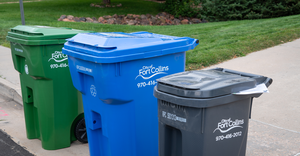AmorSui Works to Build Circular Personal Protective Equipment Model
As they generate new waste, healthcare facilities must also deal with stockpiled inventories bought in the height of COVID that have surpassed their expiration dates. Meanwhile, the healthcare sector faces mounting regulatory pressure to cut its carbon footprint. The industry is responsible for 4.4 percent of global emissions and nearly double that figure in the U.S., which is driving the adoption of more sustainable practices. Some providers are looking for alternatives to single-use supplies, including PPE, though their options are quite limited.

Since the pandemic, hospital infection control practices remain as stringent if not more so as awareness of potential for disease spread has heightened. So, health care systems continue to use and dispose of massive volumes of gowns, gloves, masks, and other personal protective equipment (PPE). About 200 million tons of single-use PPE heads to landfills daily.
As they generate new waste, healthcare facilities must also deal with stockpiled inventories bought in the height of COVID that have surpassed their expiration dates.
Meanwhile, the healthcare sector faces mounting regulatory pressure to cut its carbon footprint. The industry is responsible for 4.4 percent of global emissions and nearly double that figure in the U.S., which is driving the adoption of more sustainable practices. Some providers are looking for alternatives to single-use supplies, including PPE, though their options are quite limited.
AmorSui is one of very few companies looking to help meet the demand for reusable healthcare gear that delivers the same protection and infection control as disposables. Its isolation gowns and lab coats, made from fully recyclable polyester, are anti-microbial, contain flame- and fluid-resistant materials, and can be washed 100 times, saving 22 percent in cost when factoring in avoided disposal fees, the company says. A few case studies show that isolation gowns cut emissions by 30 percent. Now, the team is working on a takeback program to recycle their products back into raw materials for reuse at the end of life.
The manufacturer caters to several industries, though health care is the main target. To date, five hospitals are trialing the startup’s wares, swapping out their disposable gear for reusables and tapping into a full-service subscription model where AmorSui works with vendors to provide drop-off, pick-up, cleaning, and delivery service— add-ons that Beau Wangtrakuldee, co-founder and CEO of AmorSui, sees as a must to push a reusable model.
“The whole ecosystem needs to change to make medical supplies and PPE circular. You can’t just be a manufacturer. You need to begin by incorporating recyclable materials; then you must have the infrastructure to wash and the ability to manage the logistics. And you need a takeback program at the end of a product’s life where no waste is left behind,” Wangtrakuldee says.
On the back end, AmorSui tracks data on reduced carbon emissions, reduced waste, energy, and water consumption. Customers tap into a cloud-based dashboard to retrieve this data and incorporate it into their Scope 3 (supply chain) emissions reporting to show their progress toward reducing waste and carbon emissions.
Wangtrakuldee got interested in this space as a researcher in training, shortly after chemicals spilled on her lab coat, burned through it, and spilled onto her skin.
“I was having lunch with 15 women telling the story of how I had this accident because my lab coat was low quality and did not protect me, and every woman around the table shared a similar story.
“It was the first time I realized that the problem was not just my own,” she recalls.
She decided to make a better, more protective product to fill a supply chain void during the pandemic when health facilities were short on disposable PPE.
“Then I learned the problem is bigger – we have to protect the environment too. But people have been used to disposables for so long that we had to make it easy for them.”
Wangtrakuldee and her team started connecting the dots to build out the product, the circular logistics, then the data around the products, and finally the digital platform to develop life cycle analyses.
“We understand our product; we know how it’s made and its environmental impact throughout the supply chain,” she says.
Now that the team has figured out how to make the model work for PPE, she hopes to expand to more categories to help other innovators develop circular products and then be able to generate life cycle analyses.
Julia Croddick, CEO of Glow Marketing Group, a beauty and wellness product developer, wears PPE when visiting manufacturing partners.
“It usually hangs off me. I’m constantly worried about it getting caught in a machine. Also, as a brand developer that puts sustainability at the forefront of our mission, the amount of PPE that I must discard after use always makes me cringe,” Croddick says.
She figured there had to be a better way and her research led her to AmorSui.
“When I found AmorSui’s lab coat I liked that it was sustainable, and [on top of that] there are the practical functionality features, like the number of pockets, knit cuffs, and hidden snaps, which sealed the deal.”
Companies focusing on innovations in the industries Wangtrakuldee and cofounder Will McGinn target are few, and they see demand growing. Already health facilities are asking their supply chains for more sustainable options and taking what voluntary actions they can as they are called on to reduce their emissions and waste.
Globally, the Health Care Climate Challenge is building a coalition of health care institutions with participants representing hospitals and health centers in 49 countries who are supported in engaging in activities to build resilience at the facility, system, and community level to reduce the health sector’s climate footprint.
In the U.S., the White House launched the Health Sector Climate Pledge, a voluntary commitment by healthcare organizations to cut greenhouse gas emissions by 50 percent by 2030 and achieve net zero emissions by 2050. A group of 139 organizations representing 943 hospitals had signed the Pledge as of April 2024 along with health centers, suppliers, insurance companies, pharmaceutical companies, and others.
With these movements, Wangtrakuldee and McGinn believe they are well positioned to grow, especially amidst a push to eliminate single-use plastics, microplastics, and PFAS, all common in PPE.
“Our products are great for any industry where PPE is being used. Some examples include chemical labs, life science labs, biotechnology offices, pharmaceuticals, diagnostics, manufacturing, oil and gas, military, hospitality, food, and more,” McGinn says.
“Hundreds of millions of individuals wear PPE to keep them safe at work, so there’s truly a huge use case.”
About the Author
You May Also Like




